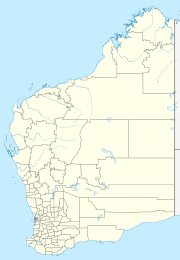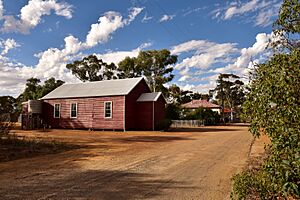Pantapin, Western Australia facts for kids
Quick facts for kids PantapinWestern Australia |
|
|---|---|

Railway Street, Pantapin, 2018
|
|
| Established | 1913 |
| Postcode(s) | 6384 |
| Elevation | 344 m (1,129 ft) |
| Area | [convert: needs a number] |
| Location |
|
| LGA(s) | Shire of Quairading |
| State electorate(s) | Central Wheatbelt |
| Federal Division(s) | O'Connor |
Pantapin is a small town located in the Wheatbelt region of Western Australia. This area is known for its wide open spaces and farming. Pantapin is about 191 kilometers (119 miles) east of Perth, the capital city of Western Australia. It's a quiet place that started because of a railway line.
Contents
The Story of Pantapin
Pantapin began its life as a railway siding in 1912. A railway siding is like a short extra track next to a main railway line. It allows trains to stop or pass each other. This particular siding was part of a new railway line being built. This line connected the towns of Quairading and Bruce Rock.
Why Railways Were Important
Railways were super important back then! They helped move goods like wheat and wool from farms to bigger towns and ports. They also helped people travel between places. So, when a railway siding was built, it often led to a small community growing around it. This is exactly what happened with Pantapin.
The Town's First Name
When the town was first planned, it was given a different name: Ulakain. This name came from a nearby water well. Water wells were vital sources of water in dry areas like the Wheatbelt. The name Ulakain was officially recorded in 1914.
A Name Change Was Needed
However, the name Ulakain caused some problems for the people living there. Residents found that their mail and other goods often went missing. It seems the name was confusing or hard to use. Because of these issues, the town's name was changed in 1921 to Pantapin. This new name helped make sure mail and deliveries reached the right place!
Pantapin Today
Today, Pantapin remains a small, quiet town. It's a reminder of the early days of settlement in Western Australia. The town's history is closely tied to the development of the railway system. The railway helped connect remote farming communities to the rest of the state.



